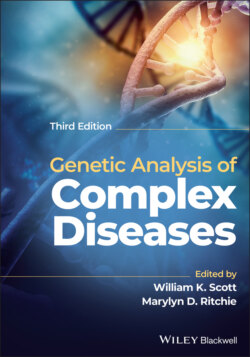Читать книгу Genetic Analysis of Complex Disease - Группа авторов - Страница 34
Hardy–Weinberg Equilibrium
ОглавлениеAnother historical landmark in genetics occurred in the early 1900s as evolutionary biologists attempted to explain why the frequency of a dominant trait or disease in the population did not increase until everyone in the population was affected. The answer to this question was provided independently by Hardy (1908) and Weinberg (1908), who predicted the behavior of genetic traits in a population using the binomial theorem. Their proof, now called the Hardy–Weinberg theorem, shows that in a large, randomly mating population, the frequency of an autosomal genetic trait (a trait that is not dependent on sex) will achieve and remain in a state of equilibrium after one generation. Several evolutionary forces can alter the equilibrium frequencies, including selection for or against a phenotype, migration into or out of a population, new mutations, or genetic drift, a phenomenon in which allele frequencies fluctuate in a small population due to chance.
Figure 2.1 Principles of Mendel’s first law of segregation of heritable characters for a dominant trait.
In a two‐allele autosomal system with alleles “A” and “a” (having frequencies p and q, respectively), p + q = 1 and p2 + 2pq + q2 = 1. The Hardy–Weinberg theorem predicts that the frequencies of genotypes “AA”, “Aa,” and “aa” are p2, 2pq, and q2, respectively. Various manipulations of these algebraic formulas allow many useful calculations, such as carrier frequencies of diseases, disease prevalence, and gross estimates of penetrance, the proportion of individuals with a specific genotype that exhibit a particular phenotype. Examples of applications of the Hardy–Weinberg theorem are shown in Table 2.1.
Figure 2.2 Principles of Mendel’s second law of independent assortment with a dominant trait.
Table 2.1 Useful applications of Hardy–Weinberg theory.
| Recall that p + q = 1 and p2 + 2pq + q2 = 1 Example 1. Cystic fibrosis (CF), an autosomal recessive disease, has an incidence of 1 in 3200. What is the frequency of CF carriers in the general population?The population frequency of the disease (1 in 3200) is represented by q2In order to calculate the frequency of the carrier state (2pq), one must first determine q q = √(1/3200) = 1/57 Since p + q = 1, p = 56/57 The frequency of CF carriers is calculated as 2pq = 2(1/57)(56/57) = 1/29, or 0.0344. Example 2. The frequency of the allele (q) for an autosomal dominant disorder in 1/100. What is the frequency of the disease itself in the population?Since the frequency of the disease allele in 1/100, the frequency of the normal allele (p) = 1 − 1/100 = 99/100.Since the disease is dominant, both heterozygous carriers and homozygous individuals are affected with the disease: 2pq + q2 = 2(99/100)(1/100) + (1/100)2 = 0.0199 Example 3. An autosomal dominant disorder with incomplete penetrance (f) has a population prevalence of 16/1000. If the allele frequency for the normal allele (p) is 0.99, what is the estimated penetrance of the disease allele?Since p = 0.99, then q = 0.01As in Example 2, both heterozygous and homozygous gene carriers are affected (assuming no difference in penetrance) between homozygotes and heterozygotes. Therefore, f(q2) + f(2pq) = 0.016 f(q2 + 2pq) = 0.016 f((0.01)2 + 2(0.99)(0.01)) = 0.016 f(0.0199) = 0.016 f = 0.804 |
